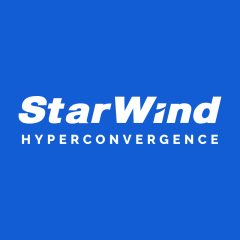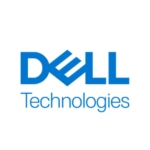What is our primary use case?
What we use it for is resilience in our Hyper-V cluster, for both the guests and the data. We have two appliances split between two physical comms rooms onsite. If we lost the power or network to one comms room, all of the guests and all of the data residing in the second comms room would be dynamically available.
How has it helped my organization?
Overall, the solution has improved our system's performance. We were with Dell products before and those products were getting towards seven years old so they were at end-of-life. This product has an element of SSD, in our particular solution. The way that the system uses SSDs to cache out load onto the SSDs for regularly-used data means that it is a much better and more modern solution. We can definitely see that in the performance.
For example, we use some database services for our management information system that manages all the kids' data. There are a lot of ways that that information is accessed, through different applications, both internally and externally. Parents might be pulling attendance information from that service. The performance of the servers in that environment is much improved on the StarWind product over the standard Hyper-V host. The fact that the storage and the hosts are on exactly the same hardware reduces the network latency and all the other bits that contribute to the speed as well.
StarWind has also saved our organization money. It has probably halved the cost of a full SAN and individual-host solution.
What is most valuable?
What makes it valuable is the high-availability. In the education field, when you've got students in classrooms, any loss of service disrupts the lessons to a point that the whole lesson is affected. For part of the business which isn't business-critical, to have a little bit of a hiccup wouldn't be such a big thing, but here, it's the high availability of service that is important.
Also, the ProActive Premium Support has picked up some issues that we wouldn't necessarily have noticed ourselves because the depth of monitoring is pretty aggressive. You have to resolve those issues with StarWind by giving them updated logs, so it does put an onus on you that forces you to be doing a better job. But in terms of day-to-day monitoring, we still do that for each of the servers within it to see if there are any specific problems that are causing performance issues. Ours is probably more of a high-level monitoring than StarWind does in its ProActive monitoring.
So, there are levels to it. They come up with some good stuff in the ProActive monitoring that we wouldn't necessarily have noticed very quickly. The upshot is that you then have to work with them to troubleshoot that issue.
We still have to do a lot of stuff that StarWind doesn't do in their ProActive monitoring, but it gives us peace of mind that somebody else is watching the services 24 hours a day, so that we're notified if there's a potential issue. All the issues that we've had have been potential problems that have been picked up and resolved before they became problems. That's the real positive spin: Because it's proactive, it's stopping you from actually having the issue that would affect end-users.
We do use network monitoring tools to monitor the network and the core processing of all of the servers in our environment, including the StarWind, but we do leave the higher-end stuff to the ProActive Support guys. There are only two of us who are full-time in IT in our organization, so we can't really afford to have bought into something that would have had a big overhead in terms of day-to-day management. StarWind is one of those things that, once it's set up and working properly, there are some checks that you would do naturally on a daily or weekly basis, but there's a whole raft of reporting tools and you're notified if there's a potential problem. It is a put-it-in-and-off-you-go kind of thing. Once that initial commissioning has been done and it's in and working, it's pretty seamless.
For how long have I used the solution?
We bought into StarWind in the summer of 2019, so it's been a little over half-a-year.
What do I think about the scalability of the solution?
In terms of the solution's hardware footprint, it's very scalable. It's important that you look at future-proofing as much as possible when you buy the product. It's important that you think about three to five years' worth of growth. The ability to upgrade is always there, but that's going to come at a cost later on. Obviously, technologies change reasonably quickly — certainly server technologies, disks, and arrays, etc. So it's good, if you want them to be truly resilient with each other, to keep them at one state of firmware revision, rate controllers, all running at the same level, etc.
For us, scalability is an interesting thing because we have two comms rooms and we want to keep things resilient between those two comms rooms. We have the option, obviously, to increase the space and add additional memory, just like with any other server. We could add a third StarWind appliance and increase our capacity in that way. Clearly, if we were going to do that, our resilience wouldn't be quite equally spread because we'd have two appliances in one comms room and one in another. For us, there are many more options than we would have with a traditional SAN. Certainly, we're not constrained by it in any way.
How are customer service and technical support?
The technical support from StarWind is excellent. The guys really know what they're doing, and they're really supportive and helpful. Their response is excellent. You feel really looked after. There is nothing that is too much trouble. You could ask them a very basic question if you were concerned about something to do with your own infrastructure that was affected by StarWind, and they're quite happy to get involved.
There's good continuity. You get a support guy dealing with you on a particular problem and he stays with it through to resolution. You're not dealing with a lot of different people. Much of the time you get the same two or three guys dealing with your account, so you know the people that you're going to be talking to and dealing with. I really couldn't rate it more highly, on a personal level. They're very proactive and very responsive.
Which solution did I use previously and why did I switch?
We had a Dell EqualLogic solution with multiple Hyper-V hosts and resilient SANs before we migrated to StarWind. For us, StarWind was a software option that would potentially reduce our costs and give us the same level of resilience that we had before. We've also increased performance and capacity.
If we had to replace the same technology in a Dell EqualLogic product, or whatever the new SAN product that they might have is called, it would cost us significantly more. Being in education, at the moment, money is quite tight. What we wanted is the best possible resilient solution at a good price point. That's what we got from it.
Also, the StarWind guys worked really hard to make the right kind of compromises to give us both the performance that we needed and a price we could afford. That's another element to this. When you buy a solution from Dell, you have to buy a particular model. There is an element of configuration, and there are discounts available depending on the time of the month or where you are in that calendar year — offers and deals to schools. Whereas StarWind was prepared to drill right down into the solution, look at exactly what we needed it to do, and make the compromises in the right places. So we still got the same level of resilience that we had before, but we got improved performance and improved capacity at a much cheaper price.
How was the initial setup?
There is room for improvement in the setup and installation phase. We had massive problems connecting the StarWind appliances to our network infrastructure. That wasn't necessarily a StarWind problem. I don't know if their business partner in the UK wasn't used to having to deal with the supply of the cabling infrastructure, but that's where the problems started.
Because of the way we are funded, I could spend the money only once. I have to write a business case for everything we do and I put all the costs in that business case. What I can't do is go off and buy a load of additional stuff because I should have added it to the business case. So the agreement was that the cabling for our infrastructure would be supplied with the StarWind but, unfortunately, they just couldn't do that. They supplied the wrong cables and the wrong number of cables. In the end, I had to go and buy all the equipment myself to do it, because they just didn't seem to be able to deal with it. I think the problem was with the UK side, with whomever they outsource the setup and installation to in the UK. If it had been a solution where they'd had to come onsite and install it, it would have been an absolute mess.
We were quoted three to four weeks for the deployment time but, in the end, it took about six or seven weeks.
We did have an implementation strategy for this product, but it all went out the window when we didn't get the cabling right. Because it's a school, the kids were on their summer break from the end of July through until the beginning of September. We had plans to do work in that time but, in the end, we just couldn't do that work because we didn't get the StarWind in early enough to do it. Some of that was our fault. We did order the product later than we wanted because we were looking at HPE, Dell, and StarWind together. But if we hadn't had the issue with the cabling, a weeks-long issue, we would have been a lot more successful in the summer.
Because that's the only time we really get a chance to do anything big on our infrastructure, some of the work we would have done in this past September will now have to be done in August of this year.
What about the implementation team?
Our experience with the StarWind partner was not the best. We spent a lot of time spec-ing and giving them the specs of every element of our network. When they failed to deliver it and we missed a number of deadline dates on the installation because of it, I just phoned up a cabling company, gave them all the details, and I had the right cables the very next day. So it wasn't a massive technical challenge. It just needed someone to take ownership of it. I don't know whether it was a financial thing or something else, but I've not been reimbursed for those cables. So in the end, I did overspend on the project. If you're going to write a business case and you're going to put the costs in it, you want those costs to be right.
In the whole scheme of things, it's not the end of the world, but was annoying. It could certainly be improved.
What was our ROI?
If we had gotten the StarWind installed more quickly, we would have migrated more to it than we have currently. Our seven years on our existing Dell solution just expired about a month ago. We've migrated the majority of our infrastructure onto the StarWind appliances, but we haven't fully migrated for the reasons I implied before. Until the summer, this year, we won't be able to migrate some elements, which is just a little bit frustrating. So at the moment, those elements are running on Dell solutions that are no longer covered by any hardware maintenance. That is a risk that I would have rather avoided.
What's my experience with pricing, setup cost, and licensing?
We bought a seven-year solution including licensing, hardware maintenance, and ProActive Support. For us, in a school, we tend to buy high-end equipment — hardware and servers — and look at them in terms of a seven-year lifespan. That's a lot more than it would be in industry, but we ideally try to specify the equipment to have that length of life, if possible, in terms of capacity; or at the very least have the option to upgrade within that time. So, our one-off costs when we bought the equipment included seven years' worth of licensing and everything else that goes with it.
We paid it all upfront.
Obviously we pay our Microsoft licensing separately and that licensing covers the operating system on the StarWind appliances.
Which other solutions did I evaluate?
We looked at Microsoft storage but what we wanted was the resilience and the dynamic replication of data across two comms rooms. Before, we did that with EqualLogic SANs and physical Hyper-V hosts, whereas now, what we've got is the storage and the hosts in one box in each comms room, with StarWind.
We looked at multiple solutions, including HPE and Dell. Dell had been our partner up until this point, but the truth of the matter is that we couldn't afford their products anymore. The cost of their products had just moved out of the reach of a school with the kind of funding we have.
All these products have the ability to do what we wanted to do: real-time failover, real-time data between both comms rooms. The step up to achieve with some of the more well-known players is quite large though. In fact, it's an order of magnitude in terms of money. In layman's language, there are tiers, or steps, that you would have to climb to get more functionality. For example, you could start including cloud, cloud storage, and more. But the jumps and the tiers with StarWind are much closer together. The costs in taking those different steps are still there, but they are much more reasonable. That's because they're wrapping up all the technology in one box, rather than buying separate boxes for separate things.
Unfortunately, in my experience, there is quite a turnaround of technical guys within the organizations you deal with, and it's not easy to get continuity from the people at most organizations to look at your particular problems. What they always want to do is sell you their "gold" product, which is fantastic and very exciting, but if you can't afford it, you can't afford it. That was frustrating for me.
I would speak to Dell, I would speak to HPE, and they would jump up in the air and say, "Oh yeah, great. We can sell you one of those, and six of these, and that will do it. Fantastic." And that would do it. But we just didn't have that kind of money. And when we went back to the table and said, "Well, that's really great, but we can't really afford that," their reaction was, "Oh, well, that's not very interesting, because we will have to this product in instead. And then you can't do this, and you can't do that." And then it was not worth buying from our perspective.
With StarWind, they were much more flexible in looking at compromises and, because it's all built into one box, they could offer us opportunities to do things in a different way and still get the majority of the functionality we wanted. With a lot of the bigger players, if you bought the kind of functionality we wanted, you got a lot of other stuff that we weren't going to use, and obviously that was built into the price. With StarWind you can pick and choose, a little bit more, which elements you want to adopt and use, without having to go to the next, big, more expensive box or software revision.
What other advice do I have?
My advice is to check it out. Everybody has a tick-box of what they want to achieve with a product. If you've got that, apply it to StarWind. Give them a chance to offer you a solution that meets all those ticks in those boxes, because I think they can do it at a very good price. There isn't really a compromise in that in any way. You're getting a really good solution at a really good price, and you're not actually making any compromises.
The biggest eyeopener for me is that there are solutions out there that don't have to cost a lot of money for a very robust and resilient solution. StarWind gives you everything that you're going to get from a traditional SAN host in one box. You get really high-grade proactive support, and the solution is scalable and cost-effective. If we hadn't had the issues with the implementation, I would be saying it is definitely on par with the more recognized players.
I'd have no hesitation in recommending it, once it has been installed, set up, and configured. It is definitely a challenger among the more traditional and more industry-recognized solutions. The others, Dell, HPE, etc., are all looking more into software storage and Microsoft storage and solutions to fill in those gaps between the tiers in their products. But I think StarWind has gotten there first.
StarWind's product is very nice and very user-friendly as well. It's very understandable from a higher-level technical point of view. There are no smoke and mirrors with it either. They're not hiding anything, they're not making it unavailable to their customers. It's all very open-book and that gives you an element of comfort when you're making a decision to move away from the more traditional ways of doing it. StarWind's openness, and the information that's available to you on their product, and how the product is going to be implemented and used, allays a lot of those fears.
Once it's installed, I would happily give it an eight or a nine out of 10. It does exactly what it says on the tin, in our experience with it.
Which deployment model are you using for this solution?
On-premises
Disclosure: PeerSpot contacted the reviewer to collect the review and to validate authenticity. The reviewer was referred by the vendor, but the review is not subject to editing or approval by the vendor.














Hello. I enjoy reading IT Central Station's competitive reviews. Out of curiosity while you were researching different SDS/HCI vSAN solutions, where did you go to obtain your research information and along the way, did you ever hear of or investigate DataCore SAN Symphony?